Lecture

On November 13, 1843, at the meeting of the Royal Irish Academy, Sir William Rowan Hamilton presented his first quaternion work, On the New Species of Imaginary Quantities (.pdf). Later, the quaternions suffered a sad fate - at first their discovery was greeted as a divine revelation, but after some forty years they caused a persistent idiosyncrasy in mathematicians, and after forty years almost no one remembered them.
Quaternions themselves, of course, are practically not to blame for such a development of events. The only thing that can probably be blamed on them is that, being an algebraic object, they looked defiantly geometrical (more on this later). All the rest is the influence of an exclusively human factor.
The story should not begin with Sir William Hamilton, but on the other, also a fairly well-known personality - a socialist banker, a close disciple of Saint-Simon Benjamin Oland Rodriguez. The son of a usurer, he graduated from the Higher Normal School in Paris in 1815. Immediately after the university, Rodriguez took up speculation on the stock exchange - and did well in them.
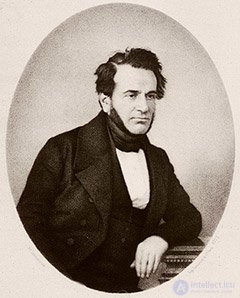
After just a few years, a recent student was already a bank director and a very wealthy person. In 1823, Rodriguez met Count Henri Saint-Simon and fell under the influence of the ideas of the utopian philosopher. The impact was so strong that Rodriguez became one of the most prominent supporters of Saint-Simon (and, in combination, the main sponsor of the philosophical research of the graph).
In 1829, already a well-known socialist, having had time to participate in the publication of the socialist magazine Le Producteur , Rodriguez left the leadership of the movement, which after the death of Saint-Simon itself smoothly but inevitably transformed into a sect. The reason for the break, as they say, was the radical views of the sectarians on the relations between the sexes. In 1832, Rodriguez finally left the community, leaving the utopians with little or no money. Until the end of his life (1851), the banker continued to call himself a convinced socialist.
Breaking with the sensimonists, Rodriguez suddenly remembered about mathematics (and maybe just about a carefree student's youth). What exactly was the impetus here is not known for certain. However, this is not important; all that matters is that in 1840 Rodriguez published a paper on the rotations of three-dimensional space in the recent periodical Journal de mathematiques pures et appliquees . This work contained an almost complete description of quaternion algebra - Rodriguez called them the parameters of a group of rotations - with the exception, perhaps, of the very word “quaternion”.
It's funny that Rodriguez's quaternions repeated the fate of his first major discovery - the formula for the Legendre polynomials, which Rodriguez derived in his dissertation De l'attraction des sphéroïdes. This formula, discovered by him at the age of 20, was published in 1816. Despite this, James Ivory and Karl Jacobi “discovered” her in 1824 and 1827, respectively. In order not to offend any of the new "discoverers", the formula was named Ivory-Jacobi. Only in 1878, Edward Heine pointed to injustice, and the formula was renamed by the name of the discoverer. Despite this, it was called the Ivory-Jacobi formula for a long time. Then, however, everything became even worse: Rodriguez’s formula was accepted as one of the definitions of Legendre polynomials and was deprived of its name altogether.
But Rodriguez’s work, even when published in a rather prestigious mathematical journal, went unnoticed. As if it was not. Perhaps she simply did not catch the eye of specialists, perhaps the mathematical work of a famous socialist banker was perceived a priori as a rich man’s whim. And in vain. If attention was paid to the work of Rodriguez on time, the fate of both the Quaternions themselves and many mathematicians could have been much less dramatic. Who knows, maybe William Hamilton himself would not have fallen victim to alcoholism. However, first things first.
While Rodriguez was engaged in mathematics in the intervals between socialist disputes, in Ireland, the greatest mathematician of his time was thinking about a completely different problem, William Hamilton. In 1833, Hamilton was the first (or one of the first) to realize that the complex numbers known by that time are represented as ordered pairs of real numbers. We would now say that Hamilton guessed to work with two-dimensional vectors, but at that time the word “vector” of mathematics was not yet invented.
The main advantage of complex numbers is that they can not only be added, but also multiplied. So, Hamilton (like many mathematicians of his time) wondered: if you can multiply two numbers, then maybe you can multiply triples? This question was important for many reasons, not the least of which was that Hamilton considered algebra "the science of the purest time."
Hamilton took a long time (and fruitlessly) to deal with the multiplication of triples. Even the children of mathematics, meeting him on the stairs every morning, asked him the same question: “Dad, have you learned how to multiply triples of numbers?” Hamilton always answered: “No, I can only add and subtract them for now.”
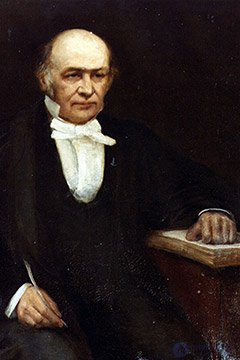
On Monday, October 16, 1843 (according to some reports, it was just on the 49th birthday of Benjamin Rodriguez), Sir William Rowan Hamilton, accompanied by his wife, was walking around Dublin in the direction of the Royal Academy. At the approaches to the Brumsky bridge, which Hamilton in all his letters for some reason stubbornly called Brohemsky, mathematics caught up with the illumination. He realized that it was necessary to work not with triples, but with four numbers. Legend has it that, in a fit of inspiration, Hamilton, right on the bridge (more precisely, on the bridge’s support by the river), got the famous ratio “i2 = j2 = k2 = ijk = -1”. About how it took the spouse mathematics, silent.
Hamilton hurried to inform his colleagues about his discovery. It is noteworthy that in his communications he again called the notorious bridge the Brohemian. A few years later, when history gained worldwide fame, the authorities in Dublin renamed the bridge. So, essentially one day, William Hamilton opened up quaternions and renamed the bridge.
Yes, by the way, even in the name of his brainchild, Hamilton could not do without pathos (however, by that time the really heavy burden of greatness pressed on Sir William himself). By his own admission (quoted from the book Elements of Quaternions , 1901), the word “quaternion” is akin to the Latin quaternio (that is, the “four”), which, in turn, is synonymous with the Greek word τετρακ. That is, the quaternion is a reflection of the very mystical tetracty of the Pythagoreans, who, as they believed, symbolizes the harmony of all four spheres of being and to which they brought their famous oath.
In general, it is obvious that Hamilton had high hopes for the discovery of quaternions.
So, it's time to more accurately formulate the task that Hamilton was thinking about.
First, we recall that the vector space of dimension n is the set of ordered sets of n real numbers. We will need spaces of dimension not higher than the fourth, so we will deal with twos, triples and quadruples of numbers. Vectors of the same dimension can be added - just add the numbers at the corresponding positions. Vectors can be multiplied by a number - just multiply by this number each component of the set. Vectors in physics usually denote all sorts of forces, speeds, accelerations, and so on. In general, quantities that have, in addition to a numerical expression, a direction.
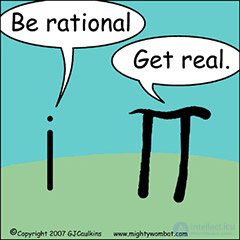
Unlike ordinary numbers that can be multiplied, it’s not easy to think up a multiplication method (with good properties) for vectors. For example, if the vectors multiply componentwise, how to add, then the product of pairs (1, 0) and (0, 1) will give (0, 0). It can be shown that because of this, none of the factors will have an inverse, that is, vectors with the condition: its product with the original gives one, that is (1, 1). In essence, this means that in the resulting algebra (the vector space with multiplication is called an algebra) cannot be divided by (1, 0). Or, for that matter, then on any vector (A, B) in which one of the components is zero.
In some cases, however, the task of finding a method of multiplication has a solution. For example, if there are pairs of vectors (A, B) and (C, D), then they can be multiplied by the formula (AC - BD, AD + BC). At first glance, this formula seems frightening and not obvious, but it is nothing but the multiplication of complex numbers. To understand this, it is enough to identify the pair (A, B) with the complex number A + B i , where i is the same imaginary unit, the number in the square giving minus 1, as well as causing hatred and contempt for everyone who suffered from mathematics in the school. Hamilton’s contemporaries believed that some tricky formula should be used to multiply, for example, triples. It was Hamilton who was looking for her.
Our ideas about the vectors, which, as already mentioned, the mathematician did not have, make it easy to understand that the task that he set for himself is insoluble. For the proof, we need the concept of a basis. Denote by 1, i, j triples (1, 0, 0), (0, 1, 0) and (0, 0, 1), respectively. The rules of addition and multiplication of vectors immediately imply that the triple (A, B, C) can be represented as A 1 + B i + C j . It is in this form that we will work with elements of three-dimensional space.

What properties of the hypothetical multiplication that Hamilton was looking for could be required? First, of course, we want, by analogy with complex numbers, i, j to be imaginary units. That is, i2 = j2 = - 1 . In this case, of course, the unit should behave as a unit, that is, 1i = i1 = i , 1j = j1 = j . In addition, our multiplication, like normal multiplication, must obey distributive and associative laws.
Now we prove that we want too much.
We will prove by contradiction. Consider the product ij . It is equal to some number from our three-dimensional space, that is, is represented in the form ij = A 1 + B i + C j . Multiply both sides of the equality to the left (we do not count on commutativity) by i . Given i2 = - 1 , we get the expression - j = A i - B 1 + C ij . We substitute the original expression instead of ij and give similar terms. We obtain the expression 0 = (CA - B) 1 + (CB + A) i + (C2 + 1) j . Equality of zero means that all components of the three must be zero. Among them, however, there is C2 + 1, which is always greater than zero. This contradiction completes the proof.

What did Hamilton come up with while walking with his wife? In fact, Hamilton's brilliant guess is doing two things. First, he somehow guessed that it was necessary to consider not triples, but four numbers. Secondly, it occurred to him to abandon the commutativity of multiplication.
It must be said that the second was truly revolutionary innovation. Now that quantum mechanics exists, noncommutative objects have become (conventionally) familiar - for example, non-commuting linear operators describing the position and impulse of a system in quantum mechanics (Heisenberg’s uncertainty principle is a consequence of non-commutativity), but in the middle of the 19th century, people about non-commutative algebras knew nothing.
So, quaternions are the ordered quadruples of the real numbers (A, B, C, D). Acting as we did above, these numbers can be written with the expression A 1 + B i + C j + D k . The relations between the symbols i, j, k are exactly those written on the Hamilton bridge, that is, i2 = j2 = k2 = ijk = - 1 . The unit ( 1 ) behaves the same as the unit in real numbers.
The scientific world met the opening of Hamilton with enthusiasm. The father of electromagnetism and simply far from being the last person in physics, James Clerk Maxwell, wrote: “The discovery of quaternion calculus is truly a leap in our understanding of the properties of space, a leap comparable, perhaps, to the discovery of Cartesian coordinate triples!” Hamilton, having proclaimed quaternions as his greatest discovery , he began with enthusiasm (as he himself put it) “to decipher the messages of the higher spheres”.
At first everything went pretty well. First, Hamilton came up with the word "vector", which we used so actively above. It must be said that Hamilton's vectors were not at all familiar to us by vectors - as he called quaternions, in which the first component, that is, A, is zero (now such quaternions are called purely imaginary). Since purely imaginary quaternions form a space of dimension three, the great Hamilton decided that his theory includes all the mechanics - because, as mentioned above, forces and other physical quantities are written in triples of numbers.
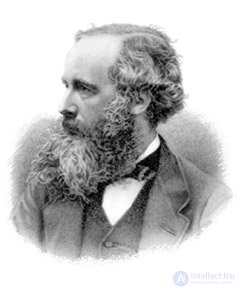
Then, writing down the multiplication of quaternions, he introduced two new operations, each of which in itself turned out to be simply very useful in the future: vector and scalar multiplication. Now these operations are known even to a schoolboy, but in the middle of the XIX century they were a real revelation.
However, for some reason it did not go further. The theory did not want to take shape. But Hamilton was unstoppable - he persistently sought a use for his Quaternions that could not be found. Different historians rate this search differently. Someone writes that this, they say, was like a fruitless search for a unified theory of everything that Einstein dealt with. Someone talks about real obsession, madness (burdened with inevitably advancing alcoholism). The situation was aggravated by the fact that it suddenly turned out: in an embryonic state, quaternions, it turns out, were still in Gauss, who simply did not attach importance to them and did not publish the results. Gauss studied the four-squares theorem — the statement that the product of two numbers, representable as a sum of four squares, is also represented as a product of four squares — a direct consequence of quaternion multiplication.
After Hamilton died, things got worse. The adherents of the “quaternion progress” became more and more similar to the aggressive sect - their scientific work was becoming more blurred, less mathematical. But attacks against the opponents of the doctrine (and the quaternions rather quickly ceased to be a mathematical theory, becoming a set of, generally speaking, false dogma from the point of view of mathematics). Here, for example, that Hamilton’s favorite student Peter Tet wrote in response to Gibbs’s Vector Analysis book: “Even Professor Gibbs should be called an obstacle to quaternion progress, because the Vector Analysis pamphlet he generated is a hermaphrodite monster that unites in themselves fragments of the ideas of Hamilton and Grassman. "
It is not surprising that by the end of the century, quaternions began to be perceived quite ambiguously. Lord Kelvin in 1892 wrote about them like this: "Hamilton's quaternions can be considered the purest evil, which did not bring anything good to those who worked with them, including, for example, Clerk Maxwell." Despite the fact that after the famous “X-rays is an invention,” the Lord’s statements should be skeptical in general, he passed the general attitude to quaternions true for that time.
Now it is clear why this happened - Hamilton miscalculated very seriously, calling purely imaginary quaternions vectors. As the appearance of tensor analysis, the basis of the entire physics, showed, the vector differs from any other ordered set of numbers only by the behavior when changing coordinates. Hamiltonian vectors behaved incorrectly and, therefore, were not suitable for the role of the very physical observables. Mathematically correct descriptions of quaternions, as well as their interpretation, were presented in the work of Rodriguez, but nobody knew about its existence, as mentioned above. And would the great Hamilton and his students listen to the statements of the French socialist banker? Unlikely.
Be that as it may, quaternions have taken their place in mathematics. В начале XX века были открыты спиноры — математические объекты, которые можно считать «правильным» обобщением векторов Гамильтона. Кроме этого, Фердинанд Фробениус доказал, что кватернионы — это, в некотором смысле, единственный способ продолжить умножение комплексных чисел на что-то большее с условием ассоциативности. Если отказаться от ассоциативности, то получатся так называемые числа Кэли, определяемые на восьмерках чисел.
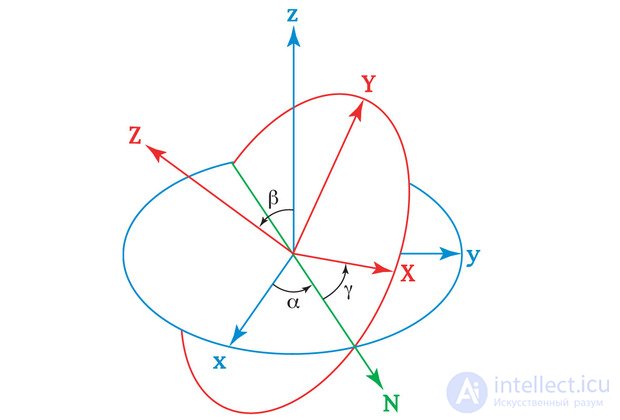
Сейчас их активно используют, например, при компьютерном моделировании, а также в датчиках ориентации на самолетах. Кватернионный подход хорош тем, что, в отличие от так называемых углов Эйлера (их, например, любят астрономы), кватернионная интерпретация лишена особенностей, то есть таких точек, которые определяются несколькими значениями параметров одновременно. Из-за этого, в частности, основанные на кватернионах вычисления более устойчивы — то есть, грубо говоря, не сильно врут, если в начальных данных содержится небольшая ошибка. С другой стороны, у кватернионов нет такого, как у углов Эйлера, наглядного геометрического представления.
In general, quaternions are an ordinary mathematical object. And he would not have such a rich history, if people were able to admit mistakes. And this conclusion, unlike the Quaternions themselves, can truly be called universal.
Comments
To leave a comment
Linear Algebra and Analytical Geometry
Terms: Linear Algebra and Analytical Geometry